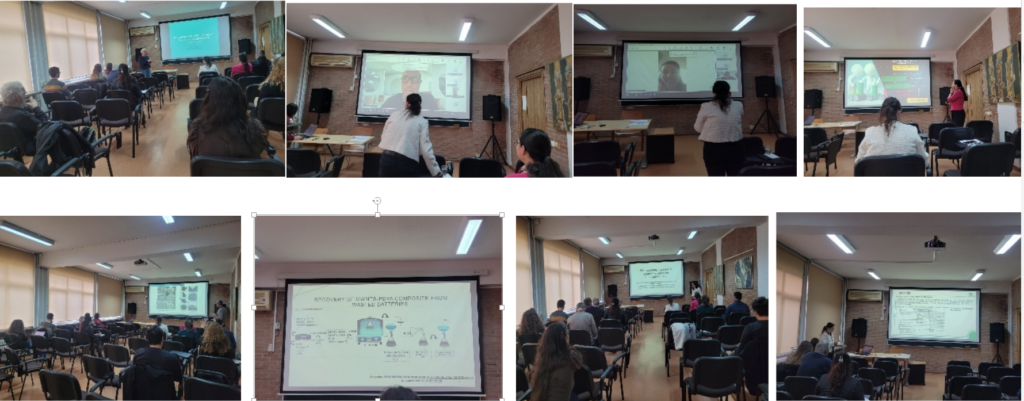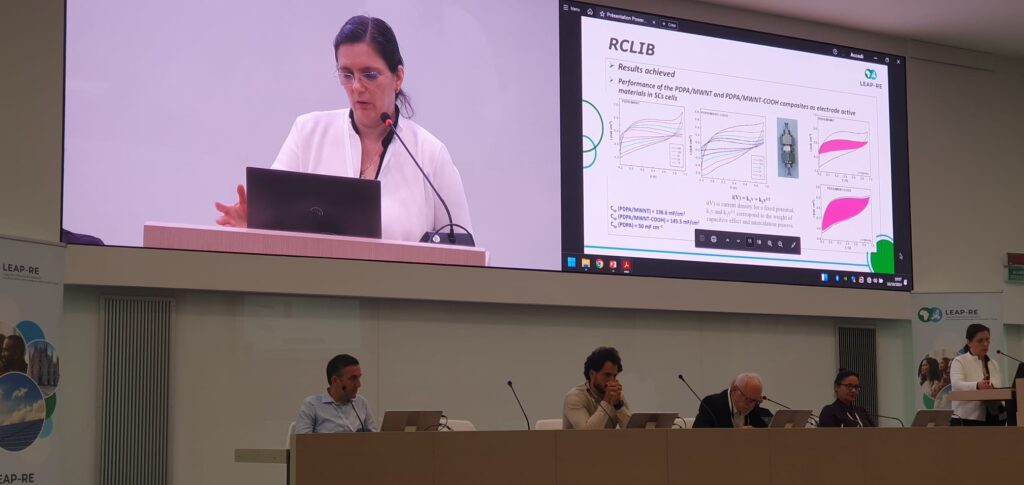Project ID: CONTRACT No. 13 din 01/03/2024
Project Director: Dr. Mihaela Baibarac
Project Type: International
Project Program: COFUND-LEAP-RE-RCLIB-1
Funded by: Romanian National Authority for Scientific Research, UEFISCDI
Contractor: National Instiute of Materials Physics
Start Date: 1 March, 2024
End Date: 28 February, 2026
RCLIB-LEAP-RE
Project Abstract:
Development in the field of rechargeable Li batteries (RLIBs) and supercapacitors (SCs) has seen rapid growth as a consequence of the demand for electric vehicles and of various devices such as wind turbines, hybrid energy storage systems for the installation of photovoltaic devices, etc. However, end-of-life (EoL) battery components induce a new environmental challenge, requiring their collection, disposal and recycling/reuse to avoid further environmental pollution. The innovation in this project envisages the life cycle analysis of novel emerging cathodes containing carbon nanotubes (CNs) & conducting polymers (CPs) from RLIB and the development of new ways for the recycling of the constituents of the cathodes at EoL. The main objectives of this project are: a) the collecting of spent RLIB, having the CP/CNs composites as electrode materials; b) the recovery of the cathode and the separation of spent electrode constituents, i.e. the CPs/CNs composite (CPs is CP in semi-doped state), polyvinylidene fluoride (PVDF), CN-Li+, CP in undoped state (CPu), LiCl, LiFP6 and super P carbon (C); c) the development of various strategies for improvement of physico-chemical properties of the CP/CNs/PVDF, CP/CNs and CP/oxidized CN (OCN) composites, e.g. by the protonic acid doping of CP, the chemical polymerization of monomers in the presence of CN, OCN, and the fibers resulted by the electrospinning; the first two methods will allow to transform CPs or CPu into CP in doped state (CPd); d) synthesis of the CP/Biochar/CNs composites and their characterization; and e) the applications of the prepared composites as electrodes for SC cells & RLIB using both classical methods and electrospinning and comparison of the obtained performance. The methodology and working plan involve the following stages: a) charge/discharge galvanostatic tests of RLIBs to ensure that the cathode based on the CP/CNs composite is at EoL and subsequent its collection; b) separation of the spent electrode constituents, i.e. CPs, PVDF, CNs and super P C, by chemical methods and their optical and structural characterization; c) preparation of new electrodes from CP, PVDF, CNs & super P C, and their testing in the SC cells & RLIB; and d) optimization of SCs & RLIBs, using prepared composites from the cathodes of spent RLIBs. To implement this methodology, we will employ: a) charge/discharge galvanostatic measurements, b) cyclic voltammetry; c) electrochemical impedance spectroscopy; d) Raman scattering, e) IR spectroscopy, f) X-ray photoelectron spectroscopy, g) X-ray diffraction, h) scanning electron microscopy, j) transmission electron microscopy, k) contact angles, l) thermogravimetry, etc. The stakeholder involvement will be: a) NIMP – the preparation of new composites, resulting from the chemical polymerization of monomers in the presence of CN & OCN, their characterization and the electrospun fibers as well as testing in SC cells & RLIB; b) CITST - electrospun fibers from CP/CN/PVDF blends and exploitation aspects; c) UM6P, UCA & UBMA - testing of the electrodes containing CPd resulted by the protonic acid doping and their hybrids, in RLIB & SC cells; and d) INFN - testing of composites, resulted by chemical polymerization of monomers in the presence of CN and OCN as well as the fibers. The expected impact consists of: a) development of a new technology for the separation of the spent cathodes constituents at EoL; b) access to recyclable technology with impact on environment, for the beneficiaries from AU and EU ; c) development of new SC cells & RLIB, using recycled compounds from spent RLIB; c) formation of new experts in the field of energy storage and wastes management to aid the transition from linear to circular economy; d) the knowledge/technological transfer, which will strengthen the cooperation between the participating institutions, having a direct benefit on the energy security of each country, enabling waste management in the field of energy storage.

B. NIMP Project Team
Dr. Mihaela Baibarac
Dr. Ion Smaranda
Dr. Andreea Nila
Dr. Malvina Stroe
Dr. Adelina Udrescu
Dr. Mirela Vaduva (Ilie)
Dr. Elena Matei
Dr. Catalin Negrila
PhD student Monica Daescu (Dinescu)
PhD student Cristina-Stefania Florica
Andreea Gabriela Androne
PhD student Teodora Burlanescu
PhD student Radu Constantin Cercel
PhD student Madalina Chivu
PhD student Mirela Andreea Paraschiv (Cristea)
Tech. Ion Lutea
Open-position
1) Exploring the Synergistic Effects of Ultrafine Polyaniline Nanofibers and Oxygen-Modified Multi-Walled Carbon Nanotubes to Enhance Intercalated Electrochemical Performance for Advanced Flexible Supercapacitors, Fahima Djefaflia, Ouanassa Guellati, Assia Nait Merzoug, Aicha Harat, Jamal El Haskouri, Izabela Janowska and Mihaela Baibarac, submitted to Materials 2025
2) Comparative Analysis of Polydiphenylamine/MWCNT Composites for Supercapacitors: Recovered vs. Commercial Nanotube Electrodes, CS Florica, A Nila, M Vaduva, C Negrila, c. Bartha, M. Aannir, I. Saadoune, S Bellucci, M BAibarac, RSC Advancesications
3) Comparative analysis of electrospinning geometries of PEO nanofiber optimization, I. G. Lupu, O. T. Cramariuc, M.R. Zvonaru, D.I. Stanciu, M. C. Grosu, E. Codau, M. Baibarac, D.L. Chicet, trimisa spre publicare la Journal of the Textile Institute 2025
1) Composites based on polydiphenylamine and multi-wall carbon nanotubes functionalized with carboxyl acid groups for applications in energy storage, C.S. Florica, M. Dinescu, I. Smaranda, M. Vaduva, A. Nila, O. Cramarius, S. Bellucci, M. Baibarac,ROCAM 2024 - 10th International conference on Advanced Materials 15-18 Jyly, Bucharest, Romania;
2) Investigation of the electrospinning parameters on the manufacture of PVDF nanofiles, D.C. Nastac, O. Cramariuc, M. Baibarac, ROCAM 2024 - 10th International conference on Advanced Materials 15-18 Jyly, Bucharest, Romania;
3) Sustainable energy solutions: developing supercapacitors with activated carbon from Italian orange waste, S. Bellucci, RICCCE 23 – 23rd Romanian International Conference on chemistry and Chemical Engineering, 4-7 September 2024, Constanta-Mamaia, Romania.
4) Keynote speaker Prof. I. Saadoune at Internaitonal conference on energy in Africa, national, regional and local energy Mix, EAMix 2024, UM6P-Benguerir, May 14-16, 2024, Morocco
5) Composites materials for applications in supercapacitors field, T. Burlanescu, S. Florica, M. Vaduva, A. Udrescu, M. Chivu, M. Baibarac, 6th International Conference on Powder Metallurgy & Advanced Materials 29 October - 01 November 2025, Cluj-Napoca, ROMANIA
6) Composite materials for applications in energy storage, C.S. Florica, M. Vaduva, T. Burlanescu, M. Baibarac, 6th International Conference on Powder Metallurgy & Advanced Materials 29 October - 01 November 2025, Cluj-Napoca, ROMANIA
Cerere de brevet OSIM A100761/2.12.2024: Metoada de separare a constituentilor catozilor din bateriile cu litiu uzate, autori: Baibarac Mihaela, Dinescu Monica, Stefania Florica, Nastac Daniela-Cristina, Cramariuc Oana-Teodora


